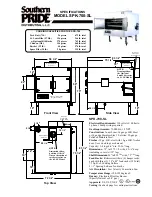
Page 11
TEST SEQUENCE:
The horn beeps 3 times with a 6 second pause and then beeps 4.
The green LED is on. The red smoke LED blinks on in synch with the 3 beeps. The red CO
LED blinks in sync with the 4 beeps.
This alarm incorporates the NFPA recognized horn signal for evacuation.
LOCAL ORIGINATING SMOKE ALARM CONDITION:
The horn beeps 3 times
with a 2 second pause and continues until the air is cleared. The green LED is on. The red
smoke LED blinks on in synch with the 3 beeps. The red CO LED is off.
NON-ORIGINATING SMOKE ALARM CONDITION:
Another interconnected alarm
has sensed smoke, causing all the other interconnected alarms to sound. The horn beeps 3
times with a 2 second pause and continues until the air is cleared. The green LED is on. The
red smoke LED is off. The red CO LED is off.
LOCAL ORIGINATING CO ALARM CONDITION:
The horn beeps 4 times with a 5
second pause and continues until the air is cleared. The green LED is on. The red smoke
LED blinks on every two minutes. The red CO LED blinks on in sync with the 4 beeps.
NON-ORIGINATING CO ALARM CONDITION:
Another interconnected alarm has
sensed CO, causing all the other interconnected alarms to sound. The horn beeps 4 times
with a 5 second pause and continues until the air is cleared. The green LED is on. The red
smoke LED blinks on approximately every two minutes. The red CO LED is off.
SENSOR TROUBLE:
This alarm contains multiple self-diagnostics. If a sensor fault is
detected, the horn chirps 3 times approximately every 60 seconds. The green LED is on. The
red smoke LED blinks on once approximately every two minutes. The red CO LED is off. The
trouble signal cannot be silenced. Reset the alarm. If this does not clear this trouble signal,
deactivate the alarm. Refer to the “alarm deactivation section.” Replace alarm immediately.
RESET ALARM:
Press the test/silence button on any alarm for 10-15 seconds, then
release. This will clear the alarm origination. Be sure to reset alarms after every alarm event.
QUICK FIND
®
ALARM ORIGINATION FEATURE:
To quickly identify the originating alarm
(the first alarm to sound in an interconnected system) after all the alarms have stopped sounding
1. Press and release the test/silence button on any interconnected alarm. After releasing the
button, the test sequence will sound on all the interconnected alarms and last for approxi-
mately 5-20 seconds.
2. Once the test sequence ends, the originating alarm will continue to sound for approximately
60 seconds which provides ample time to locate the originating alarm.
3. Remember to reset the originating alarm in order to clear the Quick Find
®
and return the
system to normal operation
4. NOTE: In a non-interconnected installation, it is necessary to test each alarm by pressing
and releasing the test/silence button to determine the originating alarm.
PRODUCT END-OF-SERVICE LIFE ALARM/LOW BATTERY WARNING:
When
it is time to replace this alarm, which is approximately 10 years of operation from initial power
up, the alarm will provide audible and visual warnings. The product end-of-service life warning
cannot be silenced. The horn chirps 2 times approximately every 60 seconds. The green LED
is on. The red smoke LED blinks on approximately every 2 minutes. The red CO LED is off.
Deactivate the alarm. Refer to the “alarm deactivation section.” Replace alarm immediately.
USING THE SILENCE FEATURE
NEVER ignore any alarm.
If the alarm sounds and it is not being
tested, it is warning of a potentially dangerous situation which requires immediate attention.
NEVER disconnect the power to your alarm to silence the horn—use the Silence feature.
Disconnecting the alarm removes your protection!
IMPORTANT! The Silence feature is intended to temporarily silence the alarm warning.
It will not correct a smoke or CO problem.
This alarm will not operate until it is activated and properly installed. This alarm should
be tested immediately after installation and then tested weekly after that. If the alarm
ever fails to test correctly, have it replaced immediately. If the alarm is not working prop-
erly, it cannot alert you to a problem. This alarm must have 120 Volt AC and activated
sealed battery power to operate properly. If the battery is dead or deactivated, the alarm
will not operate properly. The sealed battery cannot be replaced. The cover of this 10
year permanent power tamper proof alarm is sealed, and cannot be removed.
ALARM OPERATION (continued)




































